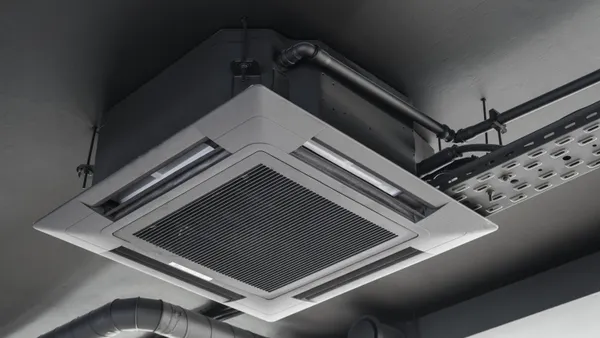Dive Brief:
- Crews broke ground last month on a 168,000 square-foot terminal expansion at Minneapolis-St. Paul International Airport that will incorporate geothermal climate control, rainwater reclamation, LED lighting, automated building monitoring and other efficient, green building systems.
- The project will involve adding two additional airline gates and increasing spacing and passenger seating for two existing northern gates, the Metropolitan Airports Commission said in a news release. It will also include new restrooms, concession spaces and additional operational support areas for airlines and tenants in the terminal’s northern end, MAC said.
- The improvements in the expanded north end of Terminal 2 are expected to reduce overall energy demand for heating and cooling by 19%, water drawn from the local water utility by 56% and energy demand for interior and exterior lighting by 23% and 62%, respectively, according to an MAC fact sheet shared with Facilities Dive.
Dive Insight:
The MAC says it is pursuing LEED Gold certification with the MSP Terminal 2 expansion project, reflecting the trend of U.S. airport renovations or expansions incorporating sustainable building systems and materials. In October 2023, Kentucky’s Louisville Muhammad Ali International Airport commissioned a $22 million geothermal heating and cooling system, the largest to date at any U.S. airport. In August, Portland International Airport in Oregon debuted an expanded main terminal — part of a $2.15 billion project to double the airport’s capacity — that includes an all-electric ground source heat pump system, a nine-acre mass timber roof and 49 skylights to reduce the need for electrical lighting.
Airports across the U.S. are also electrifying terminal buildings and ground service equipment fleets as the Federal Aviation Administration encourages airports to zero out their carbon emissions by 2050. Denver International Airport, Seattle-Tacoma International Airport and Philadelphia International Airport, among other major airports, have taken significant steps to reduce ground fleet emissions in the past decade, according to airport officials.
In Minneapolis, MSP received a $20 million grant earlier this year for the $263 million project through the Federal Aviation Administration’s Airport Terminals Program. It is one of several capacity-boosting projects in progress, planned or proposed for Terminal 2 as part of the MSP Airport 2040 Long-Term Plan, MAC said.
The Terminal 2 expansion project advances MAC’s emissions reduction plans, MAC Project Manager Ashley Vlasak said. Project planners considered “how we could maintain the technology we were selecting and how it would fit into our long-term emissions goals,” Vlasak said.
The terminal’s new ground-source heating and cooling will come from a four-well groundwater-based system developed by Minnesota-based Darcy Solutions, Vlasak said. Darcy Solutions’ selection for the terminal expansion project follows a successful single-well “proof of concept” project, providing ground-source heating and cooling to a newly constructed airfield security checkpoint building, she said.
The system will enable an 8.9% reduction in the HVAC system’s energy use for the north expansion, according to the MAC fact sheet. Crews will connect it to the terminal’s existing climate control system and replace significant amounts of HVAC equipment in the process, Vlasak said.
Any future expansion projects at Terminal 2 would aim to incorporate ground-source heating and cooling, though FAA restrictions on air-side infrastructure complicate site selection for additional boreholes, according to Vlasak. ”You want the boreholes ideally as close as you can get to the building” to minimize thermal losses in piping, she said.
Low-flow and water-efficient fixtures in terminal restrooms will reduce water demand by 31% when compared with conventional systems, MAC said. The expanded terminal’s rainwater harvesting system will collect an estimated 540,000 gallons of water annually for use in toilet and urinal flushing, reducing the amount of water drawn from the local utility by 56%, according to the MAC summary.
The expanded terminal will feature high-efficiency building envelope improvements, including triple-glazed windows installed with bamboo framing, increased wall and roof insulation and airtight exterior detailing, MAC said. The bamboo curtain wall will be a first for Minneapolis-St. Paul International Airport and will reduce the project’s embodied carbon footprint, Vlasak said.
The project's embodied carbon footprint will also be reduced through “optimized structural spans and column spacing, lowered carbon concrete mix and replacement of steel and concrete construction with mass timber construction,” according to the MAC summary. The optimized structural designs were modeled on previous MSP expansion projects, then modified to reduce carbon intensity, Vlasak said.
MAC expects Terminal 2’s northward expansion to be complete in 2027. A concurrent project to add two new airline gates at the terminal’s southern end will be open by November, MAC said.












